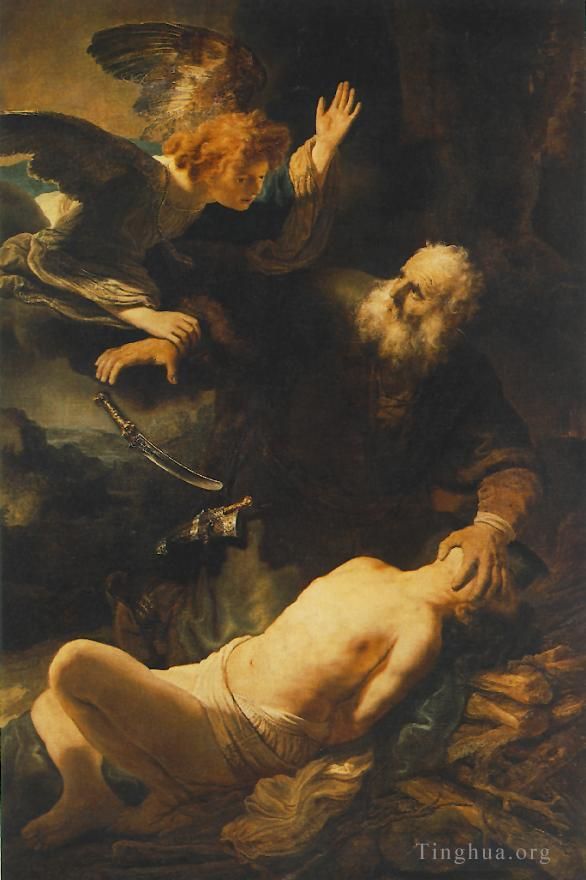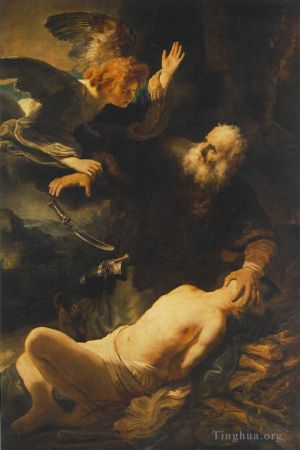Abraham of Isaac (The Angel Stopping Abraham from Sacrificing Isaac)
Rembrandt
- Price: Price on Request
- Art Type: Oil Painting
- Size:
- English Comments: 0
- International Comments: 0
- Creating Date:
- Introduction and Works of Rembrandt >>
Work Overview
- Abraham of Isaac (The Angel Stopping Abraham from Sacrificing Isaac)
REMBRANDT Harmenszoon van Rijn
1635
Oil on canvas
193 x 132 cm
The Hermitage, St. Petersburg
This is the master's largest painting from the 1630s. Rembrandt arrested the moment when the angel pins Abraham's arm who wants to sacrifice his son to God. The surprised Abraham drops his knife.
The painting is based closely on a grisaille of 1612 by his master Pieter Lastman. The vertical composition, the setting, the types and placing of the figures are very close to each other.
A second version from 1636 - perhaps the work of a coworker - is in the Alte Pinakothek, Munich.
God ordered Abraham to sacrifice his son Isaac as a test of his faith (Genesis, 22: 1-13). Abraham set out to carry out the command, proving his belief, but God sent an angel to stay his hand just as he was about to sink the knife into his son's body. Rembrandt captures all the the dramatism of the culminating moment in this terrible intended sacrifice. Abraham's amazement as the angel stops him with hand raised is revealed in his expressive gesture and the strong expression of his face, which almost borders on madness. We see a moment of great emotional tension, expressed in dynamic forms and lines. The heightened dramatism, monumental form, turbulent movement, sharp contrasts of light and shade are typical of Rembrandt's works of the 1630s and reflect in this painting the features of the Baroque style.
Comparison of the two compositions leaves no doubt that they were done by different painters. The author of the Munich canvas followed the Hermitage original and "transposed " its images in a different and individual manner. The painterly style of this painting is noted for a broad, generalized and sketch-like manner, which is especially evident in the rendering of the raised hand and face of the angel, the details of which are hardly seen. In those places where the artist strictly follows the Hermitage details (the figures of Abraham and Isaac), their treatment is much simpler, the forms are rigid and the chiaroscuro is not richly nuanced.
Despite the apparent derivation from the Hermitage model, the second version has distinguishing features at the level of the composition itself. The most important of these is the portrayal of the angel, which appears not from the left, but from behind Abraham. This moving pose emphasizes the suddenness of the situation, but deprives the scene of "dialogue" between Abraham and the angel, which plays an important role in the original composition.
The version from the collection of the Alte Pinakothek does not have the portrayal of the bowl with fire; and it pictures the ram mentioned in the Bible as replacing Isaac, Abraham's son as the sacrificial object. There are also many small changes which are noticeable not only in the lay-out but also in the colors employed in the painting.
The identity of the author of the Munich canvas has not been determined. Most researchers believe it was Govert Flinck, who in 1636 completed his studies under Rembrandt. However, the mention of Ferdinand Bol in 18th century inventories remains a weighty argument.
This version, as well as several old copies that have come down to us, attest to the success of Abraham's Sacrifice, which embodies a brilliant artistic idea.
At the very last moment, an angel stops Abraham from killing his own son, Isaac. Pretending they set out to slaughter a lamb, Abraham actually intended to sacrifice Isaac to his god.
One year on, Rembrandt would make a similar painting.
The Binding of Isaac (Hebrew: עֲקֵידַת יִצְחַק), also known as The Binding (הָעֲקֵידָה) and the Akedah or Aqedah,[1][2] is a story from the Hebrew Bible found in Genesis 22. In the biblical narrative, God asks Abraham to sacrifice his son, Isaac, on Moriah, Abraham begins to comply, when a messenger from God interrupts him. Abraham then sees a ram and sacrifices it instead.
This episode has been the focus of a great deal of commentary in traditional Jewish, Christian, and Muslim sources, as well as being addressed by modern scholarship.
- Copyright Statement:
All the reproduction of any forms about this work unauthorized by Singing Palette including images, texts and so on will be deemed to be violating the Copyright Laws.
To cite this webpage, please link back here.
- >> English Comments
- >> Chinese Comments
- >> French Comments
- >> German Comments
- >>Report
- Bathsheba at Her Bath
- The Return of the Prodigal Son
- Balaam and the Ass
- Stormy Landscape
- Christ driving the moneychangers from the temple 1626
- Young Man At His Desk
- Haesje
- St Paul at his WritingDesk
- The Abduction Of Ganymede
- Self Portrait at an Early Age 1628
- Woman in bed
- History Painting
- David and Uriah
- The Blinding of Samson
- Susanna
- Portrait Of Joris De Caullery
- Portrait of Nicolaes Ruts
- Flora
- Christ In The Storm On The Sea Of Galilee
- The beheading of john the baptist
- The Toilet of Bathsheba
- Susanna and the Elders
- Saskia in Pompous Dress
- Anna and the Blind Tobit
- Samson And Delilah
- Saskia Laughing
- Cupid Blowing Soap Bubbles
- Dead peacocks
- Self Portrait 1659
- The Holy Family with Angels
- The Artists Son Titus
- The denial of peter 1660
- The Baptism Of The Eunuch
- Repentant Judas Returning The Pieces Of Silver
- Portrait of the Artist at His Easel 1660
- Self Portrait as a Young Man 1634
- Young Woman Trying Earrings
- The Stoning Of St Stephen 1625
- Portrait Of An Eighty Three Year Old Woman
- Christ and the Woman Taken in Adultery
- Self-portrait as the Apostle Paul
- Musical Allegory
- The Artist In His Studio
- Maria Trip
- Man In Oriental Dress
- Titus at his desk
- Self portrait 1628
- The Polish Rider
- Agatha Bas
- Adoration of the Shepherds
- Young Man
- The Mennonite Minister Cornelis Claesz Anslo in Conversation with his Wife Aaltje
- Frederick Rihel on Horseback
- David Playing The Harp To Saul
- Portrait of Maria Trip 1639
- Portrait Of Amalia Van Solms
- Portrait Of A Young Woman With A Fan
- The holy family night
- The Elevation Of The Cross
- Jan Rijcksen And His Wife
- Holy Family
- Abraham of Isaac (The Angel Stopping Abraham from Sacrificing Isaac)
- The Mill
- The Risen Christ Appearing to Mary Magdalen
- The Ascension Of Christ
- Portrait of Saskia van Uylenburgh
- Self Portrait 1658
- Elder
- Portrait of Haesje van Cleyburgh
- Saul and David
- Landscape with the Rest on the Flight into Egypt
- The Conspiration of the Bataves
- Self portrait Det
- Portrait Of A Man
- The Holy Family
- Self
- Christ and St Mary Magdalene at the Tomb
- Joseph Accused by Potiphars Wife
- Artemisia
- Supper at Emmaus
- Christ Driving The Money Changers From The Temple
- The Prodigal Son in the Brothel (Rembrandt and Saskia in the Scene of the Prodigal Son in the Tavern)
- Sampling Officials of the DrapersGuild
- Danaë
- Winter Landscape
- Johannes
- JohDet
- Dr Ephraim Bueno Jewish Physician and Writer
- Saskia
- Self Portrait 1660
- Titus van Rijn in a Monks Habit
- Apostle Paul
- Samson at the Wedding
- St John The Baptist Preaching
- Portrait of Maria Trip
- The Night Watch
- Descent from the Cross
- Self Portrait 1669
- Portrait of Saskia with a Flower
- The Prophetess Anna known ass Mother
- The Man with the Golden Helmet
- David and Jonathan
- The Archangel Leaving the Family of Tobias
- Rape of Proserpina
- Portrait Of Maerten Soolmans
- Jeremiah Lamenting the Destruction of Jerusalem
- The Jewish Bride
- Christ on the cross 1631
- The Stone Bridge 1638
- Diana Bathing With The Stories Of Actaeon And Callisto
- Philosopher Reading
- Portrait Of A Woman
- The Anatomy Lesson of Dr Nicolaes Tulp
- Tobit and Anna with the Kid
- Peter Denouncing Christ
- Girl at a Window (Girl Leaning on a Stone Window Sill)
- The Raising of Lazarus
- Saskia Wearing A Veil
- Saskia As Flora
- The Visitation
- The Parable of the Rich Fool (The Rich Man from the Parable)
- Family Group
- Joseph Dream in the Stable in Bethlehem
- The Holy Family with a Curtain
- Deposition from the Cross
- Portrait Of An Old Man
- Self Portrait In A Gorget
- Portrait Of Alijdt Adriaensdr
- Slaughtered Ox (Flayed Ox or Side of Beef or Carcass of Beef)
- Portrait of Nicolaas van Bambeeck
- Portrait Of The Artist In A Flat Cap
- Philosopher in Meditation
- Self Portrait In A Plumed Hat
- The Incredulity of St Thomas
- Self Portrait 1629
- Self Portrait as the Apostle St Paul
- Two Old Men Disputing
- Aristotle with a Bust of Homer
- Belshazzars Feast
- Hendrickje Bathing in a River
- Portrait Of Maria Bockenolle
- Jacob
- Landscape with a Castle
- Portrait of Johannes Wtenbogaert
- Evangelist Matthew
- Self portrait 1632
- Portrait of a bearded man
- Self portrait 1640
- Jacob Blessing the Children of Joseph
- Portrait of a man in military costume
- The Dream of St Joseph
- Hendrickje Slapend RJM
- Portrait of Willem Bartholsz Ruyter
- In Velvet Cap and Plume SIL
- The Sense Of Sight
- Abraham Entertaining the Angels SIL
- Portrait of Willem Bartholsz Ruyter RJM
- Self Portrait 16289
- Sakia Asleep In Bed
- Study from the Nude Man Seated before a Curtain SIL
- The Blindness of Tobit SIL
- Drawing at a window
- Portrait Of Cornelis Claesz 1640
- Saskia In A Straw Hat
- Self Portrait Staring
- The Artists Father
- Ephraim Bonus Jewish Physician SIL









 Singing Palette
Singing Palette